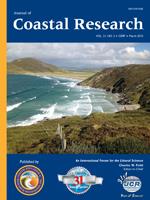Yuan, R.; Zhu, J., and Wang, B., 2015. Impact of sea-level rise on the saltwater intrusion in the Pearl River Estuary.
A three-dimensional numerical model was established based on the Finite Volume Coastal Ocean Model to study the impact of sea-level rise (SLR) on saltwater intrusion in the Pearl River Estuary. The model domain covered the entire river network, estuary, and offshore sea, and the model grid fit well with the coastlines, with a high resolution of ∼100 m in the river mouths. The model validation process showed that the model results fit the observed data fairly well. Results showed that saltwater intrusion in the river mouths was highly sensitive to SLR. Higher SLR enhanced saltwater intrusion, especially in the Modaomen waterway during neap tide. SLR enhanced the landward residual current in the Hongwan waterway and the landward bottom residual current in the Modaomen waterway, both of which carried high salinity water landward and thus made salinity higher. Isohaline of 0.45 (which is the salinity standard for drinking water) moved seaward in the Jiaomen and Hongqili outlets, whereas it moved landward in the Modaomen and Hutiaomen outlets in response to SLR. This pattern was well explained by the net water-flux changes in this branching estuary.





